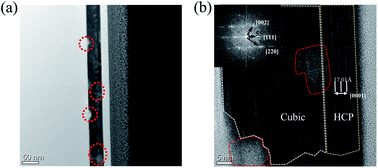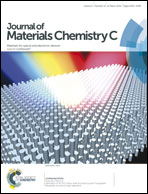Structural deformation and void formation driven by phase transformation in the Ge2Sb2Te5 film†
Abstract
The failure mechanism of reversibility in the Ge2Sb2Te5 (GST) film was analyzed microscopically based on transmission electron microscopy and ab initio density functional theory (DFT). In this study, the crystallization region was limited to the range of 500–600 °C under fast ramping rates, enabling the GST amorphous phase to approach a supercooled region above the glass transition temperature. The densification accompanying phase transformation under fast ramping rates induces two deformation behaviors: phase separation and void formation. In the disorder–order transition, the disordered domain of GST is dominated by low viscosity while approaching the supercooled region, which induces phase separation to compensate for the densification. However, coexisting cubic and hexagonal phases show void formation around the interfaces with some phase separation. The DFT calculation shows that the polymorphic transition, a fast, martensitic transformation between the cubic and hexagonal phases, induces a vacancy cluster at the interface. In the tensile stress state, void growth can be easily driven from the vacancy cluster as the nuclei for compensating for densification.


 Please wait while we load your content...
Please wait while we load your content...